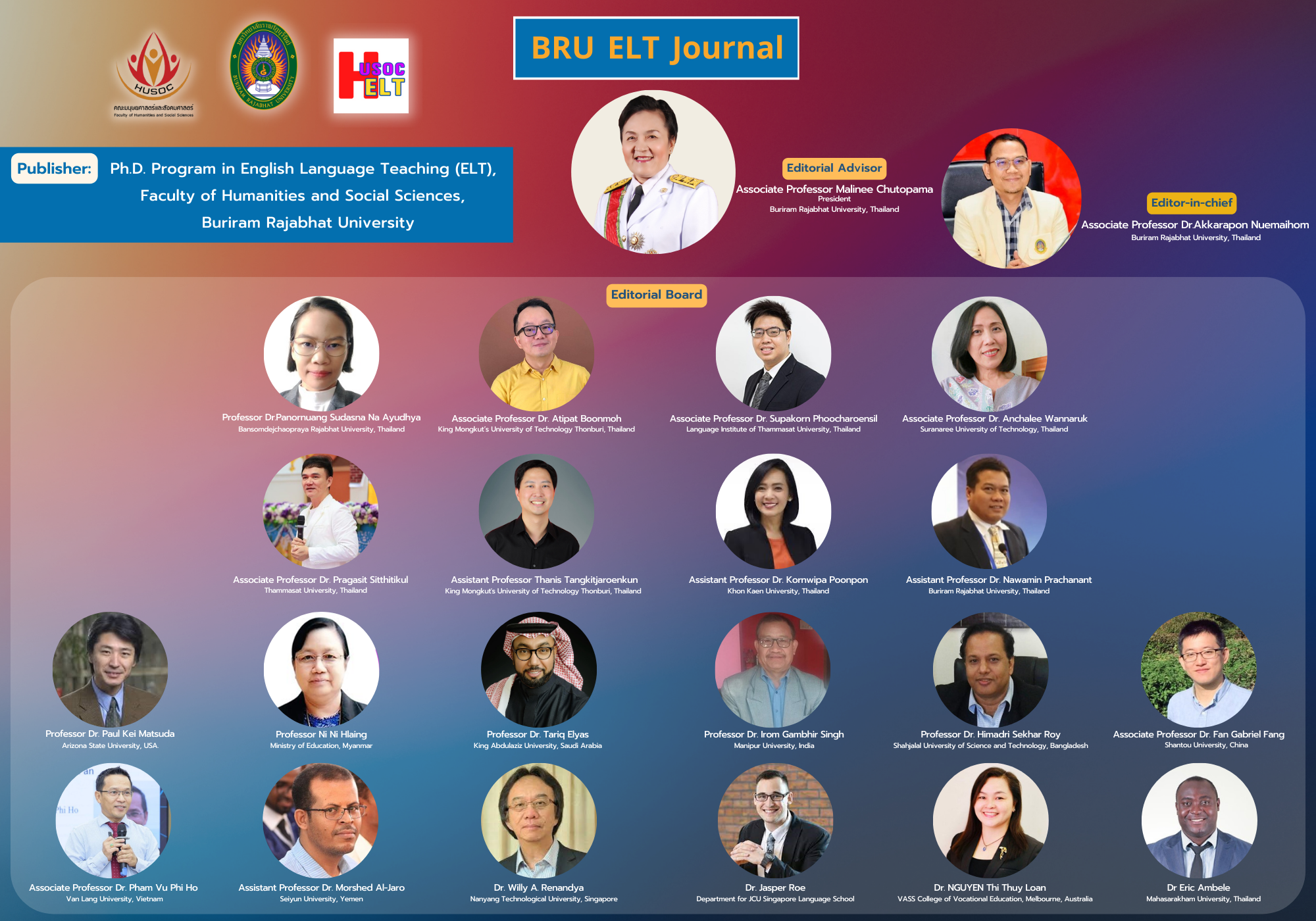Translanguaging Practice in EFL Classroom: A Comparative Study of Chinese and Indonesian Universities
DOI:
https://doi.org/10.14456/bej.2024.7Keywords:
translanguaging, EFL classrooms, higher education, comparative studyAbstract
This comparative study investigates translanguaging in undergraduate English as a Foreign Language (EFL) classrooms in China and Indonesia, filling a gap in comparative and higher education research. Employing a qualitative approach, this study employed classroom observations and interviews in two universities in China and Indonesia to explore translanguaging's pedagogical integration into language learning. A total of 70 university students and four lecturers in China and Indonesia became the participants of this study. The data collected from the transcriptions of classroom recordings were categorized based on Fang and Liu’s (2020) classifications of classroom translanguaging practices and interrater were applied to ensure the validity of analysis results. The findings show while consistent in Chinese contexts, Indonesian classrooms showed variations, notably lacking content localization. The comprehensive examination of translanguaging in Chinese and Indonesian EFL classrooms confirms its efficacy in leveraging students' existing linguistic and cultural backgrounds to foster a deeper understanding of a second language, making learning more inclusive and engaging. This study enriches the existing body of research by demonstrating the versatility and impact of translanguaging across diverse linguistic and cultural landscapes. Finally, by describing translanguaging as a bridge between students' linguistic and cultural backgrounds and EFL learning, this study offers crucial insights for educators aiming to embrace more inclusive and responsive teaching approaches, underscoring its transformative potential in EFL classrooms.
References
Akbar, R. S., & Taqi, H. A. (2020). Translanguaging as an ESL learning strategy: A case study in Kuwait. International Journal of Higher Education, 9(6), 54-63. https://doi.org/10.5430/ijhe.v9n6p54
Aribah, S. N., & Pradita, I. (2022). The use of translanguaging to facilitate students’ English learning in an Indonesian Pesantren. Communications in Humanities and Social Sciences, 2(1), 7-13. https://doi.org/10.21924/chss.2.1.2022.27
Atta, A., & Naqvi, S. B. (2022). Pedagogical translanguaging in English as second language (ESL) classrooms: A survey of existing studies. Journal of Nusantara Studies, 7(2), 120-146. https://doi.org/10.24200/jonus.vol7iss2pp120-146
Baker, C. (2011). Foundations of bilingual education and bilingualism (5th ed.). Multilingual Matters.
Boonraksa, T., & Naisena, S. (2022). A study on English collocation errors of Thai EFL students. English Language Teaching, 15(1), 164-177. https://doi.org/10.5539/elt.v15n1p164
Burton, J., & Rajendram, S. (2019). Translanguaging-as-resource: University ESL instructors' language orientations and attitudes toward translanguaging. TESL Canada Journal, 36(1), 21-47. https://doi.org/10.18806/tesl.v36i1.1301
Canagarajah, S. (2011). Translanguaging in the classroom: Emerging issues for research and pedagogy. In Li Wei (Ed.), Applied linguistics review (Vol. 2, pp. 1–27). De Gruyter Mouton.
Chania, S., & Amri, Z. (2019). An analysis of students’ grammatical errors on speaking at SEA debate at English Department of Faculty of Languages and Arts of Universitas Negeri Padang. Journal of English Language Teaching, 8(4), 515-521. https://doi.org/10.24036/jelt.v8i4.106239
Creese, A., & Blackledge, A. (2010). Translanguaging in the bilingual classroom: A pedagogy for learning and teaching? Modern Language Journal, 94, 103-115.
Creese, A., & Blackledge, A. (2015). Translanguaging and identity in educational settings. Annual Review of Applied Linguistics, 35, 20-35.
Cummins, J. (2007). Rethinking monolingual instructional strategies in multilingual classrooms. Canadian Journal of Applied Linguistics, 10(2), 221-240.
Dougherty, J. (2021). Translanguaging in action: Pedagogy that elevates. ORTESOL Journal, 38, 19-32. https://files.eric.ed.gov/fulltext/EJ1305313.pdf
Emilia, E., & Hamied, F. A. (2022). Translanguaging practices in a tertiary EFL context in Indonesia. TEFLIN Journal, 33(1), 47-74. https://doi.org/10.15639/teflinjournal.v33i1/47-74
Fang, F., & Liu, Y. (2020). ‘Using all English is not always meaningful’: Stakeholders’ perspectives on the use of and attitudes towards translanguaging at a Chinese university. Lingua, 247: 102959. https://doi.org/10.1016/j.lingua.2020.102959
Gabryś-Barker, D. (2020). The practice of classroom code-switching, translanguaging or simply alternating languages in teacher FL talk. Anglica Wratislaviensia, 58, 147-164. https://doi.org/10.19195/0301-7966.58.9
García, O. (2009). Bilingual education in the 21st century: A global perspective. Wiley-Blackwell
García, O., & Wei, L. (2014). Translanguaging: Language, Bilingualism and Education. Palgrave Macmillan UK.
Hamed, M. (2018). Common linguistic errors among non-English major Libyan students in English paragraph writing: A study of comparisons. Arab World English Journal, 9(3), 219-232. https://doi.org/10.24093/awej/vol9no3.15
Illman, V., & Pietilä, P. (2018). Multilingualism as a resource in the foreign language classroom. EFL Journal, 72(3), 237-248. https://doi.org/10.1093/elt/ccx073
Iversen, J. Y. (2020). Pre-service teachers' translanguaging during field placement in multilingual, mainstream classrooms in Norway. Language and Education, 34(1), 51-65. https://doi.org/10.1080/09500782.2019.1682599
Kampittayakul, T., & Naisena, S. (2022). A study on English collocation errors of Thai EFL students. English Language Teaching, 15(1), 164-177. https://doi.org/10.5539/elt.v15n1p164
Lewis, G., Jones, B., & Baker, C. (2012). Translanguaging: Origins and development from school to street and beyond. Educational Research and Evaluation, 18(7), 641-654. https://doi.org/10.1080/13803611.2012.718488
Liando, N. V. F., Tatipang, D. P., & Lengkoan, F. (2022). A study of translanguaging practices in EFL classroom of Indonesian context: A new concept for multilingualism. Research and Innovation in Language Learning, 5(2), 167-185. https://doi.org/10.33603/rill.v5i2.6986
Madkur, A., Friska, Y., & Lisnawati, L. (2022). Translanguaging pedagogy in ELT practices: Experiences of teachers in Indonesian pesantren-based schools. Voices of English Language Education Society, 6(1), 130-143. https://doi.org/10.29408/veles.v6i1.5136
Mahboob, A., & Lin, A. M. Y. (2016). Using local languages in English language classrooms. In P. Widodo & A. Renandya (Eds.), English language teaching today: Linking theory and practice (pp. 25-40). Springer.
May, S. (2011). The disciplinary constraints of SLA and TESOL: Additive bilingualism and second language acquisition, teaching, and learning. Linguistics and Education, 22(3), 233-247. https://doi.org/10.1016/j.linged.2011.02.001
Nur, R., Namrullah, Z., Syawal, S., & Nastrullah, A. (2020). Enhancing reading comprehension through translanguaging strategy. Journal of Language Teaching and Research, 11(6), 970-977. https://doi.org/10.17507/jltr.1106.14
Nursanti, R. R. (2021). Classroom strategies through translanguaging for multilingualism students. English Learning Innovation, 2(1), 146-153. https://doi.org/10.22219/englie.v2i1.14653
Nuruzzaman, M., Islam, A. B. M. S., & Shuchi, I. J. (2018). An analysis of errors committed by Saudi non-English major students in the English paragraph writing: A study of comparisons. Advances in Language and Literary Studies, 9(1), 31-39. https://doi.org/10.7575/aiac.alls.v.9n.1p.31
Phillipson, R. (1992). Linguistic imperialism. Oxford University Press.
Putri, D. S., & Rosa, R. N. (2020). An analysis of errors by the third year English Department students in pronouncing English vowels. Journal of English Language Teaching, 9(1), 202-209. https://doi.org/10.24036/jelt.v9i1.108150
Rabbidge, M. (2019). Translanguaging in EFL contexts: A call for change. Routledge.
Rafael, A. M. D. (2019). An analysis on pronunciation errors made by first semester students of English Department STKIP CBN. Loquen: English Studies Journal, 12(1), 1-10. https://doi.org/10.32678/loquen.v12i1.1676
Riswanto, R. (2022). Exploring translanguaging as a pedagogical strategy used by the English teacher in EFL classroom setting. Jurnal Penelitian Guru Indonesia, 7(1), 96-103. https://doi.org/10.29210/021948jpgi0005
Sahib, R. (2019). Translanguaging as a pedagogical strategy in EFL classroom: A case study at senior high school in Bulukumba regency. ELT-Lectura, 6(2), 139-146. https://doi.org/10.31849/elt-lectura.v6i2.3032
Sun, Y., Wang, Y., & Liu, J. (2015). Case study of Chinese college students’ attitudes toward only English-medium teaching in EFL classrooms. Advances in Language and Literary Studies, 6(2), 174-186. http://dx.doi.org/10.7575/aiac.alls.v.6n.2p.174
Wang, P. (2020). A case study of translanguaging phenomenon in CBI classes in a Chinese university context. International Journal of Applied Linguistics, 1-14. https://doi.org/10.1111/ijal.12324
Wei, L. (2011). Moment analysis and translanguaging space: Discursive construction of identities by multilingual Chinese youth in Britain. Journal of Pragmatics, 43(5), 1222-1235. http://dx.doi.org/10.1016/j.pragma.2010.07.035
Williams, C. (1994). Translanguaging: A bilingual teaching approach. Bangor University.
Yuvayapan, F. (2019). Translanguaging in EFL classrooms: Teachers’ perceptions and practices. Journal of Language and Linguistic Studies, 15(2), 678-694. https://doi.org/10.17263/jlls.586811
Zhang, Y., & Jocuns, A. (2022). From natural translanguaging to planned translanguaging: Developing classroom translanguaging as pedagogy in a private university in China. Arab World English Journal, 13(1), 313-329. https://doi.org/10.24093/awej/vol13no1.20
Zhou, X. (Emily), & Mann, S. (2021). Translanguaging in a Chinese university CLIL classroom: Teacher strategies and student attitudes. Studies in Second Language Learning and Teaching, 11(2), 265-289. https://doi.org/10.14746/ssllt.2021.11.2.5





